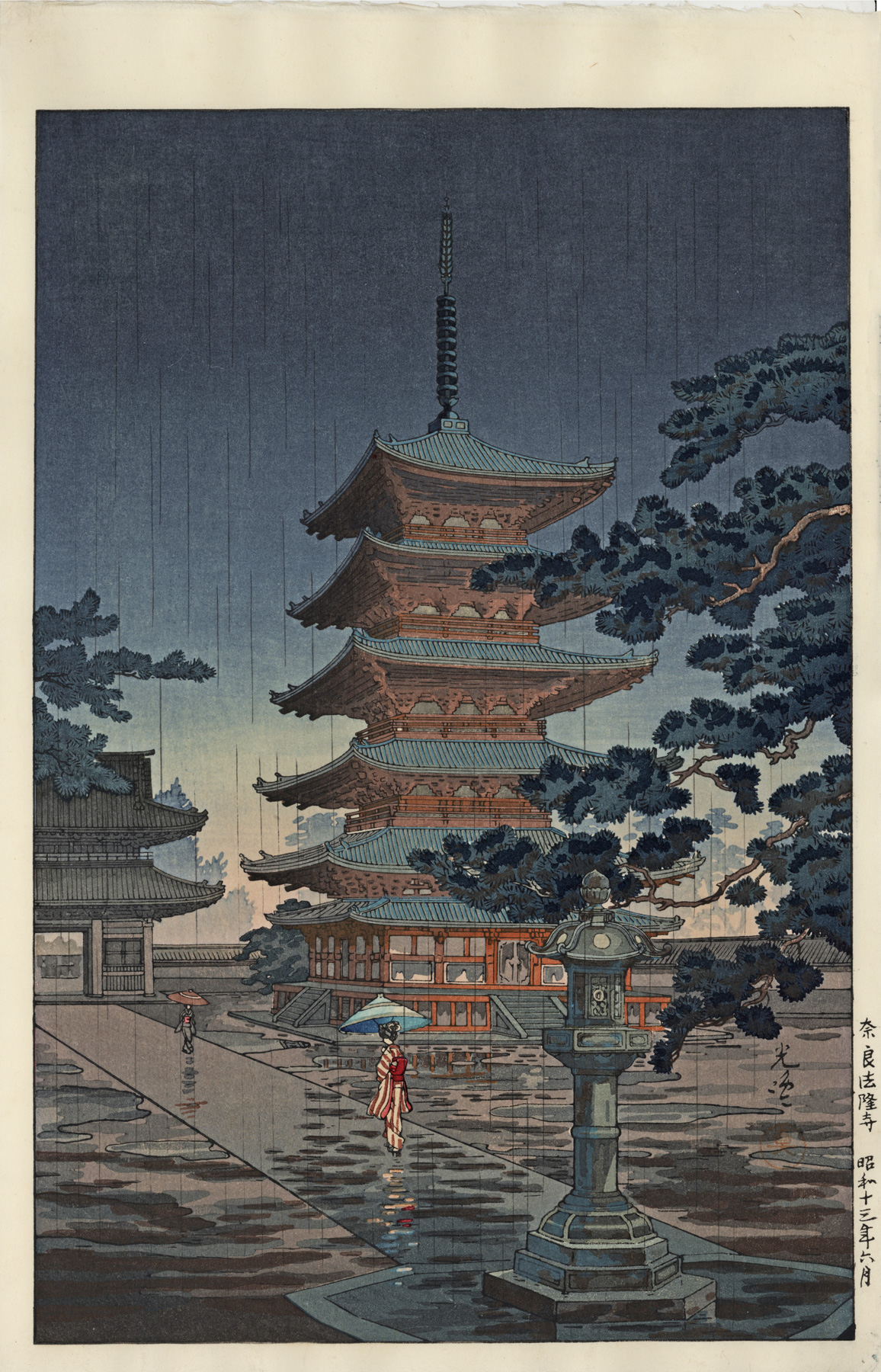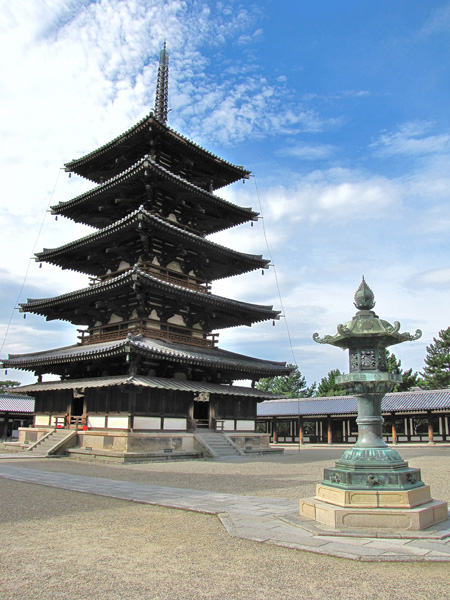About This Print
Kōitsu's rendering of the Goju-no-To (Five-Story Pagoda) in the Nara Hōryūji temple complex on a rainy day.Nara Hōryūji
| The grounds of Horyuji (Horyu Temple) house the world's oldest surviving wooden structures, conveying images of Japan as it existed more than 1,300 years ago, during the Asuka Period (A.D.mid 6th-beginning of 8th c.). The story of Horyuji's founding can be discovered in the historical writings engraved on the back of the halo of the Yakusi Nyorai Buddha statue, located on the eastern side of the room in the temple's Main Hall, and in the official inventory of Horyuji property holdings recorded in 747. According to these records, the emperor Yomei vowed to build a temple and an image of a Buddha as a form of prayer for his own recovery from illness--a vow he was never fated to fulfill, for he died shortly thereafter. These same writings state how Empress Suiko and Crown Prince Shotoku fulfilled Emperor Yomei's deathbed wish by building in 607 a temple and a statue of a Buddha, to which the temple was dedicated. The Buddha statue was of the Yakusi Nyorai (Bhaisajyaguru) -literally, "arrival as a healer"-and the temple was named the Ikaruga Temple (after the name of the location),or Horyuji ("Temple of the Flourishing Law [of Buddhism]"). |
On the fateful night of April 30 in the year 670,however,a great blaze swept through the temple grounds, leaving "not a single building "standing, as it is recorded in the ancient Chronicles of Japan (Nihon Shoki).
However, historians in the latter part of 19th century began to cast doubt on the accuracy of this account of Horyuji's destruction and to question whether or not the fire truly did occur. Although there are many questions that remain unanswered to this day, one thing certain is that Horyuji boasts an illustrious 14 centuries of continuous observance of tradition since established by Prince Shotoku, the great statesman and founder of Buddhism in Japan. Today, Horyuji is composed of the Western Precinct (Saiin Garan), which is centered around the Five-Story Pagoda (Goju-no-To) and the Main Hall (Kondo), and the Eastern Precinct (Toin Garan), which is arranged around the Hall of Visions (Yumedono). Throughout the 187,000-square-meter grounds are irreplaceable cultural treasures, bequeathed across the centuries and continuing to preserve the essence of eras spanning the entire journey through Japanese history since the 7th century.
In fact, Horyuji contains over 2,300 important cultural and historical structures and articles, including nearly 190 that have been designated as National Treasures or Important Cultural Properties. In December of 1993, Horyuji, as a unique storehouse of world Buddhist culture, became the first treasure of any kind in Japan to be selected by UNESCO as part of the World Heritage.
Print Details
| IHL Catalog | #1141 |
| Title | Nara Hōryūji (奈良法隆寺) |
| Series | |
| Artist | Tsuchiya Kōitsu (1870-1949) |
| Signature |  |
| Seal | shin 真 (see Signature above) |
| Publication Date | originally issued June 1937. This print is a later impression, produced after the artist's death. |
| Edition | late 1960s to early 1990s (see Publisher below for further dating information) |
| Publisher | Doi Hangaten - 土井版画店 (Doi Sadaichi 土井貞一) Note: No publisher's seal is present on this print. According to the Koitsu.com website http://www.koitsu.com/Research/dating_koitsu_prints/dating_koitsu-prints.htm the absence of a publisher seal indicates an unauthorized printing. To quote: "Based on an analysis of the Koitsu prints saved in my Koitsu database I would estimate around 20% of Doi-published Koitsu prints do not have any publisher seals. If your print has publisher seals they will be found in the lower area of the left margin and look similar to those shown below in the Doi section. Dating evidence suggests these appeared in the market as far back as the late 1960s until the 1990s. There was only one printer active during all this time, Seki, who was dismissed by Doi Eiichi in the early 1990s for "activities that undermined the Doi publishing house" (no doubt selling unsealed prints on the side was a part of that activity). If your Doi print has no publisher seals in the lower left margin it dates to this period." |
| Carver | unknown |
| Printer | likely Seki (see Publisher above for further information on this printer) |
| Impression | excellent |
| Colors | excellent |
| Condition | excellent |
| Miscellaneous | |
| Genre | shin hanga (new prints) |
| Format | dai-oban tate-e |
| H x W Paper | 17 1/8 x 11 1/4 in. (43.5 x 28.6 cm) |
| H x W Image | 15 1/2 x 10 1/4 x in. (39.4 x 26 cm) |
| Collections This Print | Art Gallery of New South Wales 421.2001 |
| Reference Literature | The Catalogue Raisonne of Tsuchiya Koitsu Meiji to Shin-Hanga, Watercolours to Woodblocks, Ross F. Walker and Toshikazu Doi, Ohmi Gallery Publishing, 2009; Koitsu.com site reference TK-DH-050 |



